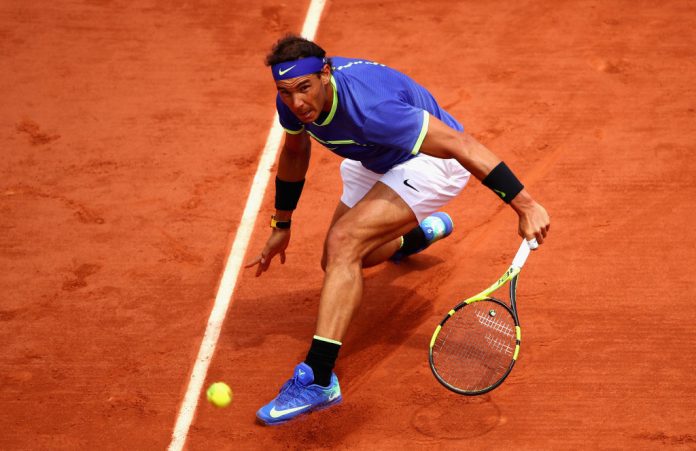Does any athlete have more gestures and tweaks than Rafa? Time and again we see his endearing rituals. He obsessively arranges his bottles by his bench. Like Steph Curry, he sprints out when he first takes to the court, and as he’s about to serve he displays a determined grimace (or is it a snarl). Perhaps to calm himself and make things just right before he serves, he gently flicks his shirt and face, and, most famously, tugs the backside of his shorts.
Rafa was raised by a Spanish village: a beloved mother, a soccer-playing father and the most important uncle in tennis history – Toni Nadal. Without “Uncle Toni,” the kid might have gone for soccer or would have played tennis right-handed. Now we see – arguably beyond Laver, Connors and McEnroe – the greatest left-handed player ever, and, even more than Borg, he’s tennis’ foremost claymeister. With his ten French Open wins, Rafa has dominated a single Slam like no other.
The 31-year old Nadal, who is No. 1 in the world again, has won 16 Slams, including last year’s French and US Opens. He emerged from a small island to conquer the tennis world. Fortunately, he crosses boundaries with ease. Yes, tennis is his thing, but he adores golf, and, better yet, heading out for a day of solitary fishing – a Mediterranean man at one with his sea.
Similarly, Nadal seems at one with a clay court. He’s mastered every nuance of the art of tennis dirt. His high-bouncing forehand is legendary. He glides with glee and seems to have come up with his own slide rules. Playing defense, he snaps wicked running backhand flicks that are twisting snakes. His drop shots are cruel. Mary Carillo asked, “Have you ever seen anyone who has the same sense of the rhythms of a clay court match as Rafa?”
Yet, unlike many other masters of the soft stuff, Rafa has ventured far beyond clay, winning the Australian Open, two Wimbledons, three US Opens and seven Masters 1000 tourneys on hardcourts.
More than these notable triumphs, as he evolved from boy to man, the Federer-chasing Majorcan won our hearts. Even when his English was modest, Rafa-talk delighted our ears. Still a bit of a work in progress, his words at times can seem a bit mystifying. But, not to worry, they always right themselves with an almost poetic alchemy that enchants.
As a newbie on the tour, Rafa sported long hair, sleeveless shirts that displayed his godly physique, and seemingly dysfunctional pirate pants. Now his hair is shorter, his gear is usually more conventional, and he’s the only fellow we know who wears an $850,000 watch on court.
With Rafa there are certain givens. His rippled muscularity amazes. While off-court his fleshy Tommy Hilfiger underwear ads astound, on-court he plays with a singular physicality. Yet, for all his ferocity there is a sweetness and guile-free innocence to the man. We see hints of the boy he once was. He’s a gentleman, who, unlike many others, has never smashed his racket. His foundation empowers kids from Anantapur in India to Catalonia in Spain.
Along with Federer, Rafa’s greatest foe is his body. He has a 23-15 winning record over Roger, but his knees, his right hip and his feet have a winning record over him. So we ask, with all the torque he uses to blast his forehands, why hasn’t he blown out his shoulder or wrist? Without his array of injuries, would he have been the best of all time? And has any athlete this side of Mickey Mantle, Tiger Woods, Brian Baker or Juan Martin del Potro suffered more injuries? Most recently a hip ailment sidelined him from late January to early April.
Still, most every spring – like flowers blossoming in a field or sparrows returning to Capistrano – Rafa emerges to dominate the clay-court season. His results evoke a boisterous fanfare. He’s won ten times in Paris, Monte Carlo, and Barcelona, where they named their center court after him. Seven times in Rome and five times in Madrid – wow! Some say he ushered his greatest foe to the sidelines, as Federer has again bypassed the clay circuit.
Ultimately, Nadal’s greatest asset is his will – his ferocious intent. Not since Jimmy Connors have we seen a man treat every stroke with such hell-bent resolve. He twirls, he spins, he swoops. He sprints and somehow makes that extra stride. He attacks and pounces with a breathless fury. Sledgehammer intensity is his brand. He’s relentless. Only outright winners defy him. They call him “The Bull.” But, no bull, he pounces like a panther. “I will prevail” is his ethos. Tennis has no greater warrior.
Still, we wonder: can the aging lefty icon continue to unleash his marquee shot, his mean, heavy forehand that pins and punishes like no other? Will the Spaniard with the underrated serve and his laser, two-fisted backhand still be able to craft points with the inventive creativity that’s baffled a generation of foes? In other words, will this savvy man of motion who defends with such speed still be able to rule on clay?
For now, the question is not so much whether Uncle Toni’s absence will make a difference. It’s not whether his still-in-the-rearview-mirror foes – say, young studs like Sascha Zverev and Dominic Thiem, or some Frenchman hoping for homegrown glory – will subdue him. Rather it’s whether Nadal’s battered, war-weary body will allow him to perform his greatest ritual of all – his annual spring offensive.
Around the globe, legions of Nadal’s fans know it’s the time of year to shout loud the two most glorious words in the Nadal universe – “Vamos Rafa!”



















